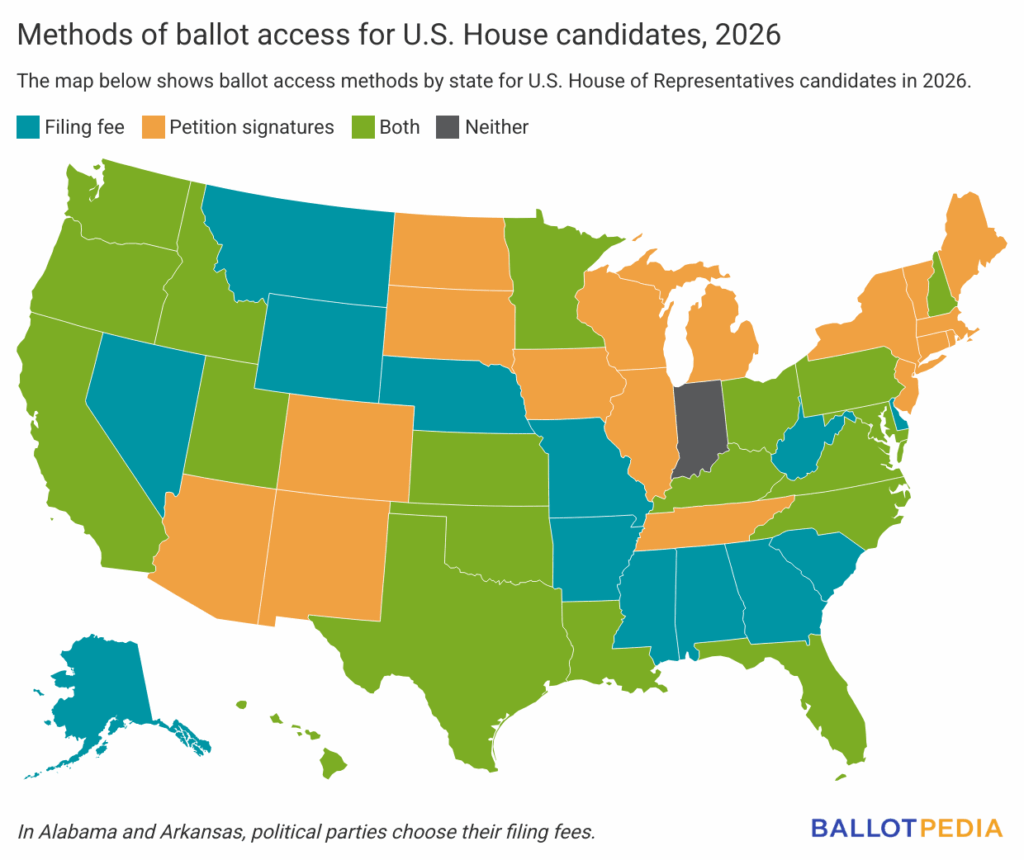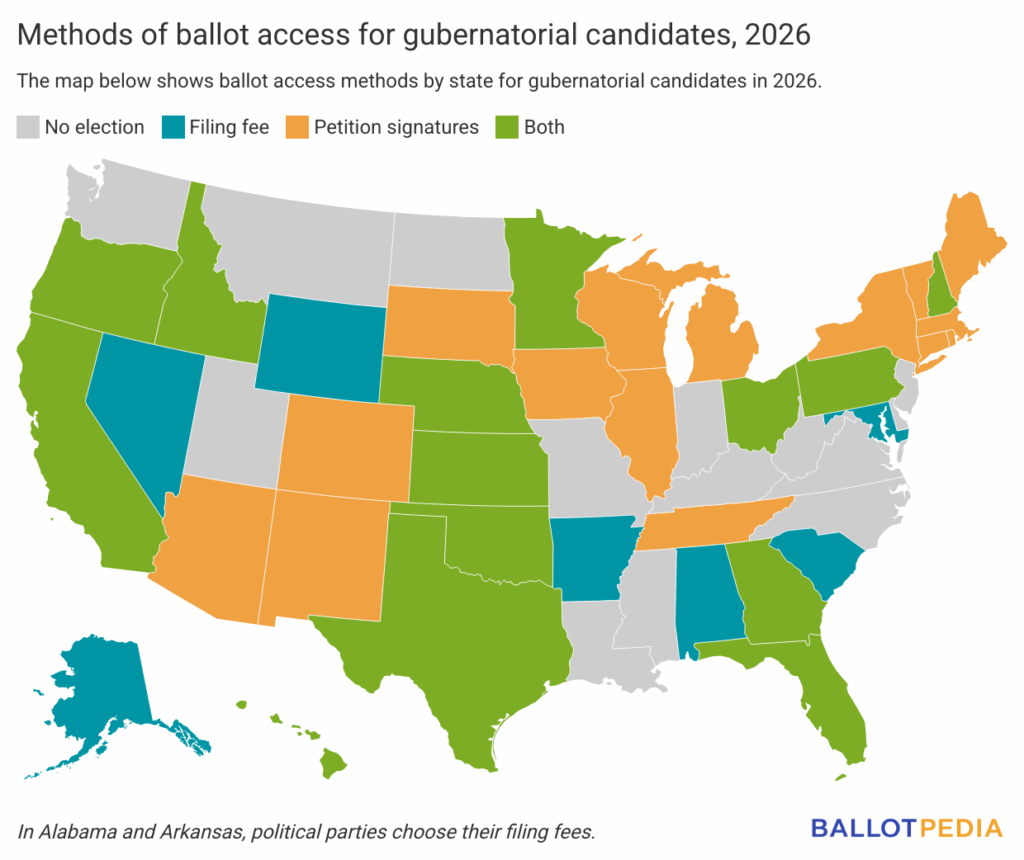Welcome to the Friday, Nov. 21, 2025 Brew.
By: Lara Bonatesta
Here’s what’s in store for you as you start your day:
- An overview of ballot access requirements for candidates running in 2026
- Civic education is more than names, dates, and places: It’s vital to the American experiment, by Leslie Graves, Ballotpedia Founder and CEO
- Incumbent Dan Crenshaw and state Rep. Steve Toth to face off in Republican primary for Texas' 2nd Congressional District on March 3
An overview of ballot access requirements for candidates running in 2026
Candidates for state and congressional office must meet various filing requirements and deadlines. State ballot access laws determine the requirements that candidates must meet to appear on the ballot. In some cases, political parties can also set ballot access requirements.
Some states require candidates to submit a certain number of signatures for ballot access, while others require filing fees, and some require both. In some states, the number of signatures needed is fixed, while in others, it is a percentage of votes cast in previous years for a particular office. Similarly, some states' filing fees are a set dollar amount, while others are a percentage of the office's salary. The number of required signatures and the filing fee can also vary between offices and the candidate's party affiliations.
Below is an overview of the primary election filing requirements for partisan candidates running for office in 2026.
U.S. Senate
Of the 35 states with U.S. Senate elections, 23 require or allow candidates to gather signatures to get on the ballot. Of those with a set number of signatures, Michigan requires the most, at 15,000. Kentucky requires the least, at two.
Twenty-two states require candidates to pay a filing fee. Of those with set filing fees for U.S. Senate candidates, the fees in Delaware and Florida are the highest at $10,440. Alaska and New Hampshire have the lowest fee, at $100.

U.S. House of Representatives
All 435 U.S. House districts are up for election. Forty states require or allow candidates to gather signatures to get on the ballot. Of the states with a set signature requirement, Utah requires the most, at 7,000 registered voters who are residents of the congressional district in which the candidate is running. Kentucky requires the least — two signatures.
Forty-two states require or allow candidates to pay a filing fee. Of the states with set filing fees, Florida's is the highest, at $10,440, and New Hampshire’s is the lowest, at $50.

Gubernatorial
There are gubernatorial races in 36 states next year. Thirty-three of those states require or allow candidates to gather signatures to get on the ballot. Among the states that have a set number of signatures required to get on the ballot, Michigan and New York require the most, at 15,000. Hawaii requires the least, at 25.
Thirty-two states require or allow candidates to pay a filing fee. Of the states with set filing fees, the highest fee is in Texas, at $3,750. The lowest fees are in Alaska and New Hampshire, at $100.

State legislatures
Forty-six states are holding elections for 88 state legislative chambers.
Thirty-four states holding senate elections require or allow candidates to gather signatures to get on the ballot. Of those with a set number of required signatures, Utah requires the most, at 2,000, and New Hampshire requires the least, at 20. Thirty-five states require or allow candidates to gather signatures to get on the ballot for the lower chamber of the legislature. Of those with a set number of required signatures, Utah also requires the most, at 1,000, and New Hampshire requires the least, at five.
Thirty-five states require or allow candidates to pay a filing fee. The highest state senate filing fee is in Texas at $1,250. The lowest is in New Hampshire, at $10. For lower chambers, Texas and New Hampshire are also the highest and lowest, with Texas requiring a $750 fee and New Hampshire requiring a $2 fee.

Click here to read more about ballot access requirements for candidates in all 50 states and here to see a list of 2026 filing deadlines.
Civic education is more than names, dates, and places: It’s vital to the American experiment

“Voters Demanded to Know Why Polls Were Closed. There Was No Election.”
The major storylines flowing from the Nov. 4 elections focused on who won, who lost, and what it all might mean for the 2026 elections. But there was one small story that stood out not for what it says about winners or losers, but for what it says about voter engagement and education.
This story begins with a social media post from Kentucky Secretary of State Michael Adams. In response to several calls and complaints to his office from voters about why polling places in the Bluegrass State were closed that day, Adams posted on the state’s social media accounts:
We’re getting calls about polls being closed. They are closed because we do not have elections today. Kentucky votes next year. You cannot vote today in Kentucky for the mayor of New York City or the Governor of Virginia. Sorry.
In an interview with the Lexington Herald-Leader, Adams said the reason why Kentucky didn’t have elections this past Nov. 4 was because of a constitutional amendment voters approved in 1992:
“In 1992, Kentuckians voted to amend our state constitution to give themselves, and election officials, a year off from elections once every four years,” Adams told the Herald-Leader in an emailed statement, referring to ballot measure No. 2, put before voters in the general election that year.
Voters in the state can be forgiven if they’re not familiar with constitutional amendments that were approved more than 30 years ago. And they might also get a pass for wondering, what with the volume of media coverage focused on elections in New York City, Virginia, New Jersey, and elsewhere in the country, that surely there must be an election in Kentucky, too.
But what about those who contacted Adams' office asking why they couldn't vote locally in the New York City mayoral race, or the Virginia gubernatorial contest?
Many of those who responded to Secretary of State Adams’ social media post, in addition to some gentle ribbing, echoed Adams’ call for civic education.
That ought to be a point on which we can all agree. Yes, there is a need for comprehensive civics education in the United States. An informed, educated, and engaged electorate is essential for a healthy constitutional republic.
Our representative democracy depends on more than the mechanics of casting a ballot. It requires a public that understands what elections are happening, and where. It means voters must know who the candidates are on their ballots, and what they stand for.
Our electoral system functions even better when voters understand the fundamentals of the American system of government. This includes major concepts like federalism and the rule of law.
That extends into more complex but critical areas of public policy, like understanding the history, function, and future of the administrative state.
And that understanding brings with it the critical realization that while what happens in Washington, D.C. may grab the biggest headlines, the heavy lifting of our national experiment is self-governance that occurs at the local level, where city council and school board members, and a host of other elected officials are setting policies that have an immediate and sometimes personal effect on our daily lives.
The confusion of a handful of people in Kentucky is a small story that has a larger lesson: democracy isn’t self-sustaining. Only active, engaged, and informed people can make it work.
That means we must treat civic education as vital public infrastructure and devote the same time, effort, and resources necessary to keep our nation healthy on Election Day and every day.
Incumbent Dan Crenshaw and state Rep. Steve Toth to face off in Republican primary for Texas' 2nd Congressional District on March 3
Incumbent Daniel Crenshaw (R), Steve Toth (R), and four other candidates are running in the Republican primary for Texas' 2nd Congressional District on March 3, 2026. The filing deadline is Dec. 8. Crenshaw and Toth are leading in fundraising and local media attention.
According to the Houston Chronicle’s Jeremy Wallace, Crenshaw, who media outlets described as a rising star in the GOP after he was first elected, “has the power of incumbency and is one of the most recognizable members of Congress.” Toth is a state representative who, the Texas Tribune's Gabby Birenbaum described as "aligned with the rightmost faction of the Texas Legislature...by far the best-known primary opponent Crenshaw has faced in his career." Crenshaw defeated Jameson Ellis (R) 75%–17% and 60%–40% in the 2022 and 2024 primaries.
Crenshaw was elected to the House in 2018 and is a U.S. Navy veteran. He is running on his record which he says includes bringing flood mitigation funding to the district and “leading the fight in Congress to defeat the Mexican drug cartels.” Crenshaw says he stands for "common sense policies that ensure our nation’s prosperity and security, represent our Foundational values, and give Texans a reason to once again be proud of their leaders."
Toth was elected to the Texas House of Representatives in 2012. He ran unsuccessfully for state Senate in 2014 and U.S. House in 2016 before being re-elected to the state House in 2018. He is running on his record as a state legislator, which he says includes “banning both Critical Race Theory and Social Transitioning of Children in Texas schools” and securing “billions in funding for border security initiatives as a member of the Appropriations Committee.” He is also a pastor and a small business owner. Toth’s campaign website listed “Securing Our Southern Border,” “Fighting Liberal Indoctrination”, “Our National Security,” among his top priorities.
As of November 2025, The Cook Political Report with Amy Walter, Inside Elections with Nathan Gonzales, and Larry Sabato’s Crystal Ball each rated the general election Solid/Safe Republican.
Texas conducted redistricting between the 2024 and 2026 elections. As a result, district lines in this state changed. According to an Inside Elections analysis, under the old map, Donald Trump (R) would have won the district by 24 percentage points in the 2024 presidential election. Under the new map, Trump would have won the district by 23 percentage points.
Martin Etwop (R), T.C. Manning (R), Nicholas Plumb (R), and Ava Zolari (R) are also running in the primary. Plumb completed Ballotpedia's Candidate Connection survey. To read those survey responses, click here.
If no candidate receives more than 50% of the vote, the top two vote-getters will advance to a runoff on May 26.Click here to learn more about the Republican primary for Texas’ 2nd Congressional District.

